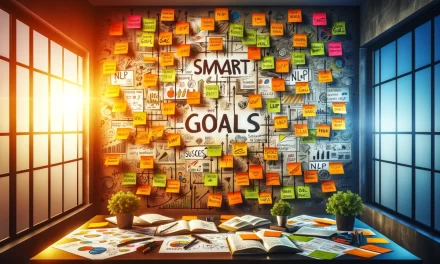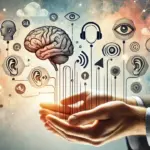Introduction
Neuro-Linguistic Programming (NLP): A Gateway to Enhanced Communication
In our rapidly evolving world, effective communication stands as a cornerstone of success across all spheres of life. Whether you’re a student grappling with academic challenges, a business professional navigating the corporate labyrinth, a coach striving to connect with clients, or even a housewife managing daily household dynamics, the ability to convey and interpret messages effectively is invaluable. This is where Neuro-Linguistic Programming (NLP) emerges as a transformative tool.
At its core, NLP is a psychological approach that links neurological processes, language, and behavioral patterns learned through experience. It offers a unique framework for understanding and directing human experience, communication, and behavior. NLP is not just a set of techniques; it’s a mindset, a way to understand how our language and thoughts shape our reality. For those new to digital marketing, especially coaches, mastering NLP can be a game-changer, enabling them to connect deeply with their audience and convey their messages more persuasively.
This blog post aims to demystify NLP and its application in effective communication. We will explore various NLP communication strategies that can be seamlessly integrated into your daily interactions. From enhancing interpersonal skills to refining your speaking abilities, NLP offers a plethora of tools for communication enhancement. Whether you’re using NLP for clearer communication in a professional setting or employing NLP techniques for better communication in personal relationships, the benefits are manifold.
As we delve into the world of NLP, remember that this is not just about theoretical knowledge. It’s about practical application. We will provide real-life examples, actionable insights, and even visual aids to ensure that the concepts are not only understood but are also ready to be implemented in your everyday communication. By the end of this post, you’ll have a solid foundation in NLP and a new perspective on how to interact with the world around you, making every conversation more meaningful and effective.
Stay tuned as we embark on this journey to unlock the full potential of your communication skills through the power of NLP.
Understanding NLP and Its Role in Communication
Decoding NLP: The Art and Science of Effective Communication
Neuro-Linguistic Programming (NLP), at its essence, is a fascinating exploration of the human mind and its influence on communication. Originating in the 1970s, NLP was developed by Richard Bandler and John Grinder, who were intrigued by the connection between neurological processes, language, and behavioral patterns. NLP is grounded in the idea that our words and thoughts shape our reality and that by altering these, we can transform our experiences and interactions.
To understand NLP’s role in communication, it’s crucial to recognize that it’s more than just a set of techniques; it’s a mindset, a way of perceiving and approaching interactions. NLP posits that we all have internal maps of the world, shaped by our experiences and perceptions. These maps guide how we communicate and interpret the world around us. NLP techniques aim to refine these maps, making our communication more effective and our understanding of others deeper and more empathetic.
For coaches, especially those venturing into digital marketing, NLP offers invaluable tools. It helps in crafting messages that resonate with a diverse audience, from students seeking guidance to professionals looking for career advancement. By understanding and applying NLP principles, coaches can enhance their ability to connect with clients, tailor their communication strategies, and foster meaningful interactions.
One of the key aspects of NLP in communication is its emphasis on the power of language. The words we choose and the way we frame our messages can significantly impact how they are received. NLP encourages the use of positive, clear, and empowering language, fostering an environment conducive to growth and understanding. It also highlights the importance of non-verbal cues, teaching us to read and respond to the unspoken elements of communication effectively.
In essence, NLP equips individuals with a deeper understanding of how communication works at a fundamental level. It’s a tool for enhancing clarity, empathy, and effectiveness in interactions, making it an essential skill for anyone looking to improve their communication abilities, particularly in the digital realm where every word counts.
Fundamental NLP Communication Strategies
Harnessing the Power of NLP for Enhanced Interactions
Neuro-Linguistic Programming (NLP) offers a suite of strategies that are fundamental in transforming the way we communicate. These strategies are not just theoretical concepts; they are practical tools that can be applied in everyday interactions to improve understanding and connection. Here, we explore some of the key NLP communication strategies that are particularly beneficial for coaches, educators, and professionals in all fields.
Rapport Building: At the heart of NLP is the ability to build rapport with others. Rapport is the bridge of trust and understanding that connects you to someone else. NLP teaches techniques like mirroring and matching body language, tone of voice, and speech patterns to create a sense of empathy and alignment. For coaches, especially in digital settings, establishing rapport can be achieved through attentive listening, acknowledging client concerns, and mirroring their communication style in written or verbal exchanges.
Meta-Model Questions: NLP introduces the concept of the Meta-Model – a set of questions designed to clarify and specify communication. These questions help in uncovering the underlying meaning in vague statements and challenge limiting beliefs. By asking targeted questions, coaches and therapists can guide their clients to greater self-awareness and more precise thinking.
The Milton Model: Contrasting the Meta-Model, the Milton Model involves using artfully vague and metaphorical language to induce a trance or relaxed state. This technique is particularly useful in therapeutic settings or when addressing a broader audience, allowing individuals to find personal meaning and relevance in the message.
Anchoring: This technique involves associating an emotional response with a specific trigger (like a touch, sound, or visual cue). Coaches can use anchoring to help clients evoke positive states or to anchor themselves in a state of confidence and clarity before a coaching session.
Reframing: NLP teaches the power of reframing – changing the perspective on a situation to see it in a new, more positive light. This strategy is invaluable in helping clients overcome mental barriers and viewing challenges as opportunities.
Incorporating these NLP communication strategies can significantly enhance the effectiveness of interactions. Whether it’s in a coaching session, a classroom, or a business meeting, these techniques foster clearer, more empathetic, and impactful communication.
Effective Communication with NLP: Techniques and Applications
Elevating Communication Skills with NLP: Practical Techniques and Their Impact
Neuro-Linguistic Programming (NLP) is not just a theoretical construct; it’s a practical toolkit for enhancing communication in real-world scenarios. By applying NLP techniques, individuals from various professions can achieve clearer, more effective communication. Let’s delve into some of these techniques and their applications in different settings.
Sensory Acuity and Calibration: NLP emphasizes the importance of being attuned to the sensory cues of those you are communicating with. This involves noticing subtle changes in body language, tone of voice, and facial expressions. For instance, a teacher can use sensory acuity to gauge a student’s understanding and engagement, adjusting their teaching style accordingly. Similarly, a coach can calibrate their approach based on the non-verbal feedback received from clients during a session.
The Use of Metaphors: Metaphors are a powerful NLP tool for conveying complex ideas in a relatable way. They are especially useful in coaching and therapy, where abstract concepts need to be communicated clearly. A business coach might use a sports metaphor to explain team dynamics, making the concept more accessible and engaging for the client.
Pacing and Leading: This technique involves matching the communication style of your conversation partner (pacing) and then gently guiding them towards a new perspective or state (leading). For example, a counselor might initially match a client’s pessimistic tone and then gradually introduce more positive or solution-focused language.
Logical Levels of Change: This NLP concept helps in structuring communication to bring about change. It involves addressing issues at different levels, from environment and behavior to values and identity. A business leader, for instance, can use this framework to address organizational challenges, ensuring that communication targets the appropriate level for maximum impact.
Chunking: This involves breaking down large pieces of information into smaller, manageable units (chunking down) or grouping smaller pieces of information into larger categories (chunking up). In a teaching context, chunking can help in presenting information in a way that’s easier for students to absorb and understand.
Future Pacing: This technique involves guiding someone to visualize a desired future outcome, making it feel more attainable. A therapist might use future pacing to help a client envision a life beyond their current challenges, instilling hope and motivation.
These NLP techniques, when applied skillfully, can significantly enhance the quality of communication across various fields. For coaches venturing into digital marketing, these strategies are particularly valuable. They not only improve client interactions but also aid in creating compelling, persuasive content that resonates with the target audience. By mastering these NLP techniques, professionals can transform their communication skills, leading to more effective, impactful, and fulfilling interactions.
NLP for Effective Interpersonal Skills
Cultivating Stronger Relationships through NLP
Interpersonal skills are crucial in every aspect of life, from professional settings to personal interactions. Neuro-Linguistic Programming (NLP) offers a unique approach to enhancing these skills, making communication more effective and relationships more fulfilling.
Active Listening: NLP emphasizes the importance of active listening, which involves fully concentrating, understanding, responding, and then remembering what is being said. This skill is vital for coaches and therapists, as it helps them understand their clients’ needs and concerns more deeply. Active listening also involves paying attention to non-verbal cues, which can often convey more than words.
Empathy and Understanding: NLP techniques foster empathy by teaching individuals to view situations from others’ perspectives. This skill is essential for building strong relationships, as it helps in understanding the emotions and motivations of others. For example, a business leader using NLP can better understand their team’s challenges and motivations, leading to a more cohesive and motivated workforce.
Effective Questioning: Asking the right questions is a key aspect of NLP. Open-ended, probing, and reflective questions encourage deeper conversation and understanding. In a coaching scenario, effective questioning helps in uncovering underlying issues and guiding clients towards self-discovery and solutions.
Conflict Resolution: NLP provides tools for effective conflict resolution. By understanding the communication style and psychological needs of the parties involved, one can navigate conflicts more effectively. NLP techniques like reframing can help in changing the perspective of a conflict, turning a confrontation into a constructive discussion.
Building Rapport: Rapport is the foundation of effective interpersonal relationships. NLP teaches techniques like mirroring and matching, which involve subtly matching the body language, tone, and speech patterns of the person you are communicating with. This creates a sense of familiarity and trust, making interactions smoother and more productive.
By integrating these NLP techniques into daily interactions, individuals can significantly improve their interpersonal skills. Whether it’s in a professional setting, like coaching or therapy, or in personal relationships, NLP provides the tools to communicate more effectively, understand others better, and build stronger, more meaningful relationships.
Enhancing Clarity and Precision in Communication with NLP
Achieving Clear and Precise Communication Through NLP Techniques
Clarity and precision are the hallmarks of effective communication. In the realm of Neuro-Linguistic Programming (NLP), several techniques are specifically designed to enhance these aspects, making interactions more impactful and understandable.
Model of the World: NLP teaches that everyone has their unique “model of the world” shaped by personal experiences and perceptions. Recognizing and respecting these individual models is key to clear communication. For instance, a coach should tailor their language and examples to align with the client’s world view, ensuring messages are received as intended.
Specific Language: NLP encourages the use of specific, concrete language over vague terms. This precision helps in avoiding misunderstandings and ensures that the intended message is conveyed. For example, instead of saying “improve performance,” a more specific phrase like “increase sales by 10% within the next quarter” gives a clear, measurable goal.
Feedback Mechanism: NLP underscores the importance of feedback in communication. Regularly checking in and clarifying ensures that the message is understood as intended. This is particularly useful in digital marketing, where immediate responses can guide the direction of a conversation or strategy.
Meta-Model: The NLP Meta-Model is a set of questions designed to clarify and specify language. It challenges generalizations, deletions, and distortions in communication, encouraging more precise and detailed exchanges.
By incorporating these NLP techniques, coaches, educators, and professionals can significantly enhance the clarity and precision of their communication. This not only aids in conveying messages more effectively but also fosters a deeper understanding and connection with the audience, whether in personal interactions or digital marketing campaigns.
NLP Tools for Effective Speaking and Listening
Mastering the Art of Expression and Reception with NLP
Effective speaking and listening are critical components of successful communication. Neuro-Linguistic Programming (NLP) offers tools that enhance both these skills, ensuring that messages are not only conveyed effectively but also received and understood accurately.
Anchoring for Speaking Confidence: NLP’s anchoring technique can be a powerful tool for speakers. By associating a state of confidence with a physical gesture or a mental image, speakers can trigger this confident state whenever needed. For instance, a coach about to deliver a webinar can use an anchor to instantly boost their speaking confidence.
Pattern Interrupts for Engagement: NLP suggests using pattern interrupts to capture and retain the audience’s attention. This involves breaking the usual pattern of communication to re-engage listeners. A sudden pause, a rhetorical question, or a shift in tone can effectively recapture the audience’s focus.
Reflective Listening for Understanding: This involves actively listening to the speaker and then reflecting back what you have heard. It ensures that the listener has accurately understood the message and gives the speaker an opportunity to clarify if necessary. This technique is invaluable in coaching and therapy, where understanding the client’s perspective is crucial.
Calibration for Effective Listening: Calibration involves being attuned to the non-verbal cues of the speaker. By observing body language, facial expressions, and tone of voice, listeners can gain deeper insights into the speaker’s emotions and intentions, leading to more empathetic and effective communication.
By integrating these NLP tools into their communication repertoire, individuals can significantly enhance their speaking and listening abilities. This not only improves the quality of interactions but also fosters deeper connections and understanding, whether in personal conversations, professional coaching sessions, or digital marketing communications.
Incorporating NLP in Everyday Communication
Integrating NLP Techniques into Daily Life for Enhanced Interactions
The true power of Neuro-Linguistic Programming (NLP) lies in its application in everyday communication. By incorporating NLP techniques into regular interactions, individuals can experience a significant improvement in how they connect, understand, and engage with others.
Utilizing Positive Language: One of the simplest yet most effective ways to use NLP daily is to consciously choose positive, empowering language. This shift in language can change the tone of conversations, whether it’s with family, colleagues, or clients, leading to more positive outcomes.
Active Listening in Conversations: Applying active listening in everyday interactions ensures that you are fully present and engaged in the conversation. This not only improves understanding but also demonstrates empathy and respect for the speaker, strengthening relationships.
Goal-Oriented Communication: NLP encourages clarity in communication objectives. Whether it’s a casual chat or a business meeting, being clear about what you want to achieve from the conversation can lead to more focused and fruitful interactions.
Adapting to Different Communication Styles: NLP teaches the importance of adapting your communication style to match that of your conversation partner. This flexibility can greatly enhance the effectiveness of your interactions, making them more harmonious and productive.
By integrating these NLP strategies into daily communication, individuals can navigate various social and professional scenarios more effectively. These techniques not only improve the quality of interactions but also contribute to personal and professional growth, making every conversation an opportunity for positive engagement and learning.
Conclusion
In conclusion, Neuro-Linguistic Programming (NLP) offers a rich array of techniques that can profoundly enhance communication skills. By understanding and applying these strategies, individuals from all walks of life can improve their interactions, build stronger relationships, and achieve more effective outcomes in both personal and professional settings. Whether you’re a coach, educator, business professional, or simply someone looking to improve your communication skills, NLP provides practical tools for clearer, more empathetic, and impactful conversations. Embrace these techniques and embark on a journey of improved communication, deeper connections, and personal growth.










